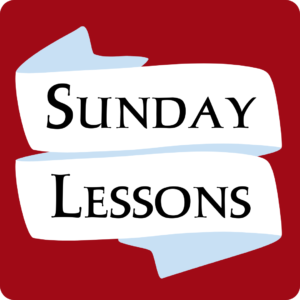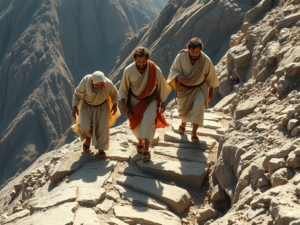Worship Guide for March 2, 2025
Like TV Guide, but from God! Find the text of the Prayers of the People and Sermon below. Use the buttons provided to find other worship materials.
To see the Worship Guide for other weeks, click here.
Prayers
Weekly Prayer List Recording:
Prayers of the People (Sunday):
Last Sunday After Epiphany
March 2, 2025
The response to the bidding, “Lord,” is “Hear us”
Lord in time and space – as we prepare for the keeping of a Holy Lent we ask that you will give us courage and persistence to hold fast to the hope that is within us in a world increasingly deaf to the values and expectations of your kingdom. Lord, Hear us.
We pray for the Church and her life: For Sean, Presiding Bishop, and Nicholas, our bishop; for Hosam, Archbishop of Jerusalem; for Pope Francis; for Bartholomew, Ecumenical Patriarch, and other Christian leaders. Lord, Hear us.
We pray for the world and its pressing needs: Distressed by changes in American foreign policy, we continue to pray for the coming of peace with justice in the Middle East, remembering especially Palestinian communities in Gaza and the West Bank, increasingly under violent siege. [Pause count of 5]
Alarmed by the treatment of President Zelensky on his recent visit to Washington we continue to pray for a negotiated peace in Ukraine that honors a commitment to Ukrainian sovereignty and future self-determination [Pause forcount of 5]. Lord, Hear us.
We pray for the nation: We pray for wisdom to perceive and courage to grasp the hidden opportunity in a time of crisis.
[The congregation is invited to bring your concerns for our country to the Lord, either silently or aloud–]
We especially remember those working in government service and in public education;
Lord, we ask you to bless the Congress and the Courts in upholding the integrity of the Constitution. Lord, Hear us.
We remember the earth, our increasingly fragile island home. We pray for a strengthening of emergency services and necessary infrastructure to meet the challenge of climate instability. Lord, Hear us.
We pray for all in need and in any kind of trouble: for those whose strength is failing through ill health, whose spirits are flagging through depression, whose determination is being sapped through addiction, that they might know God’s comforting presence and healing. Lord, Hear us.
We remember with love those who have asked for our solidarity in prayer: Mary, Sam, John, Arline, Raya, Sara, Kevin, and those we name. Lord, Hear us.
We pray for our own needs, together with those nearest and dearest to us, remembering especially those celebrating birthdays this week; Robin Higbie, Kate Chute, Jerry Knowles, and Ann Pellegrino. Lord, Hear us.
Rejoicing in the fellowship of so great a cloud of witnesses, we remember those we love but see no longer, especially those we name. We remember those experiencing loss.
Lord, Hear us.
The celebrant adds a concluding prayer.
Sermon Recording
Sermon Recording:
It’s the Coming Down that Matters
The Rev. Mark Sutherland
In this life, it’s not what happens on the mountaintop that shapes us but how we conduct ourselves on the downward journey into the inevitable confrontation with the challenges of life in the world ruled by the demons of our age.
Sermon audio
Looking at the gospel reading from Luke chapter 9, you will see that we are given two options. The first is to read only verses 28-36. Here, we hear the story of Jesus taking Peter and John on a mountain climb. On reaching the summit, Jesus becomes transfigured – his face shining with intense illumination and his clothes glowing with a dazzling whiteness. We note the echo of Moses’ experience on the mountaintop of Sinai reported in the OT lesson from Exodus 34.
Between verses 28- 36, we learn that the disciples gaze amazed yet fearfully at Jesus, who Moses and Elijah suddenly join. Together, they begin discussing what is still to come, namely Jesus’ journey to his death in Jerusalem.
The last Sunday after Epiphany is not the celebration of the feast of the Transfiguration – which takes place on August 6th. Today, we simply hear the story of Jesus and the disciples’ transfiguration experience as the transition story that marks the movement from Epiphany into Lent.
Epiphany means showing – a peeling away the layers of appearance to reveal the underlying true nature of things. Epiphany season begins on January 6th with the event known as The Epiphany – recalling the visit of the Magi to the infant Christ Child – signaling the non-Jewish world’s recognition of Jesus as the promised one foretold by Israel’s prophets. A second epiphany with a small e occurs a week later when we celebrate the Baptism of Jesus – during which the voice from heaven reveals Jesus as God’s openly acknowledged son. After his baptism, the clouds part as the heavens open to herald God’s proclamation of Jesus’ divine sonship. During Jesus’ transfiguration experience, once again, we hear the voice of God repeating the earlier proclamation of Jesus’ sonship – but in contrast to the clouds parting and the heavens opening, this time the voice sounds from within the density of a dark cloud descending to envelop the mountain summit.
The story of the Transfiguration functions as a final epiphany with a small e – in this case, a piercing of the layers of appearance exposing the underlying hidden truth of Jesus’ identity as a preparation for his fateful journey to Jerusalem. The story also functions as a literary device, marking the halfway point in the gospel narratives between Jesus’ ministry in Galilee and his journey to Jerusalem – his death and resurrection. We can picture the Galilee ministry progressing towards an epiphany on the mountaintop. Likewise, we can picture the trip to Jerusalem beginning with the descent from the mountain – setting out on the hard road through Lent to the destination of the cross before the final epiphany of his resurrection.
The story of the Transfiguration operates symbolically similarly to when Dr Martin Luther King Jr. proclaimed I have been to the mountain top, and I’ve seen the Promised Land. No one ever thought he was claiming to have climbed a mountain to describe the view on the other side. They understood his use of the mountaintop as a symbol with deep theological and biblical resonance. Likewise, for the synoptic gospel writers – Mark, Matthew, and Luke – the story of the Transfiguration is loaded with theological and biblical resonance, linking the beginning of the Jesus story with its ultimate ending – from birth through death to resurrection.
So far, so good. But suppose we continue to read beyond verses 36 to 43. In that case, we enter into a bracketed section of text – bracketed to indicate that in the mind of the Lectionary compilers, these verses are optional. The bracketing might suggest a desire to keep the gospel reading short. But it also strikes me that the bracketing of verses 37-43 not only leaves the story incomplete but also might indicate how much more comfortable we are with experiences of transcendence than those of immanence.
Mountaintop experience symbolizes much hankered after peak experience – the spiritual high – the blissful experience. In contrast, the journey down shows Jesus reentering the noise and chaos – the tension, the messiness of the world. The arguing and recrimination in the scene that greets him at the bottom of the mountain is emblematic of our life experience when we come down from the highs of peak experience. Transitory bliss is soon dissipated amidst the more familiar feelings of anger, frustration, exasperation, and disappointment. Jesus does not hold back in expressing all these feelings in the face of human propensities and pretensions as he cries You faithless and perverse generation, how much longer must I be with you and bear with you?
Today’s gospel marks our transition from Epiphany to Lent. Figuratively, we descend from Epiphany’s heights to accompany Jesus on the rugged and stony road through Lent that will lead us to Jerusalem and beyond. This year, we hear the readings for the last Sunday before Lent sounding within the unique context of the present time in which we can’t ignore the fact that today, we revisit the story of the Transfiguration of Jesus on the mountain in the context of profound shock at the speed with which the world as we have come to know it seems to be coming apart at the seams.
We are sick at heart –aching with concern for the thousands of legal refugees now stranded across the globe at ports of debarkation for the US – clutching their State Department permissions to enter the US now seemingly not worth the paper they were written on. Our concern encompasses the legal refugees newly arrived in the US and whose resettlement programs have now been defunded. Our hearts are full of fear for the families of undocumented immigrants – families where parents and children at the beginning of each day wonder if they will still be together at day’s end.
We seethe with rage at the callous indifference shown to thousands of faithful civil servants whose employment has been summarily terminated by the click of the send button.
We blanch with shame as America insidiously affirms Russian aggression before the General Assembly of the United Nations. We watch in fascinated horror as foreign leaders are welcomed, unaware that the Oval Office has now been transformed into the set of The Apprentice. Bravo to President Zelensky, who, unlike the ritual humiliation of Jordan’s King Abdullah two weeks ago, refused to play the game and pretend he didn’t recognize that the subtle art of diplomacy is now replaced by the crude art of the deal.
Our faith in sound government is further corroded by a deepening cynicism as we witness once more a cowered Congress embarking on swinging budget cuts – not to put a dent in the national debt but to give wiggle room for a trillion dollars in tax giveaways to the 1%.
But lest I be accused of laying blame at others’ doors, as the blame game goes around and around, there is enough blame to crown all our heads with shame. Dietrich Bonhoeffer –our go-to prophet for our age – speaking to his fellow pastor-resisters during Christmas 1942 pulls us up short, reminding us of our failings. To paraphrase him: we stand in grave danger lest we become even more the silent witnesses of evil deeds. We stand in peril of further perfecting our defense skills, relying on our learning in the arts of obfuscation and equivocal speech. If we fail to protest in the face of a deluge of unbearable events, we will become more worn down – become – as if it were possible – even more cynical – so that Bonhoeffer’s question – Are we still of any use, becomes the question for our age.
Kristopher Norris, Pastor of Calvary Baptist Church in Washington DC, in the Baptist Global News wrote: With family separations at the border, automatic detentions, dangerous dehumanizing rhetoric from our highest office and authoritarian misappropriations of scripture from our highest attorney, many churches and Christian leaders have remained silent witnesses. Three-fourths of white evangelicals continue to support these policies. Other churches and Christian leaders have responded with appropriate outrage. We’ve said this is not who we are — as Americans or as Christians. But Bonhoeffer’s words should compel us to take a deeper look at ourselves, at our history, and acknowledge that this is not true…. this is who we are as Americans ….. this is who we are as Christians ….. for this – citing the legacy of white Christian Nationalism is our collective history.
On Ash Wednesday, we will hear the Church’s invitation to the observance of a holy Lent. Among the traditional disciplines – the practices of discipleship – repentance is named as the chief way to make a right beginning. It is not only the best way to make a proper beginning, but it will remain the only way we will stay self-reflective and on course for Jerusalem.
Repentance is the mark of our mortal nature, and repentance must become our byword as we accompany Jesus through the arid landscape of Lent, navigating the stony path to Jerusalem. In this life, it’s not what happens on the mountaintop that shapes us but how we conduct ourselves on the downward journey into the inevitable confrontation with the challenges of life in the world ruled by the demons of our age.





